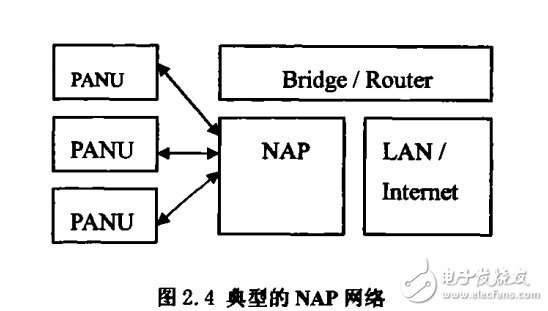The Bluetooth Personal Area Network (PAN) application specification defines a method for enabling Bluetooth devices to join a personal area network, specifying network discovery, network formation, address allocation, address resolution, domain name resolution, bridging, or routing between Bluetooth devices in a single master-slave network. And network security, network access of one or more Bluetooth devices, using the BNEP protocol to exchange completely unmodified Ethernet payloads between Bluetooth devices. PAN is positioned in home and small office applications. Its main applications include voice communication gateways, data communication gateways, information appliances interconnection and automatic information exchange.
The Bluetooth personal area network application framework includes two network structures, a network access point (NAP, Network Access Point) and an intranet (ON, Groupad-hoc Network). A network access point, also known as a network access point, is a device with one or more Bluetooth radios that acts as a bridge, proxy or router between the LAN, GSM, etc. network and the Bluetooth network. The network access point provides network services for each connected Bluetooth device, such as resources shared on the LAN. Networking is a wireless ad hoc network composed of some mobile devices without the need for other network hardware or network facilities. This network provides support for shared connections within the LAN. There is also a device called PANU (PAN User) in the Bluetooth PAN. The client of the above two networks appears in the Bluetooth network and is synchronized by the server (GN or NAP).
Network model of networking (GN)
A Bluetooth device with GN service can exchange Ethernet packets with all other Bluetooth devices connected to it, which is achieved through the support of Panyu P. GN allows mobile hosts to form an ad hoc network without using any hardware devices. GN can provide synchronization, DHCP address allocation and other services to the PANU connected to it. GN can be understood as a typical piconet. In this piconet, GN itself is the master in the piconet, and one or more PANUs connected to it are the slaves in the piconet. GN can communicate with PANI "point-to-point or point-to-multipoint", but these communications are carried out under the control of the GN. A typical GN network is shown in Figure 1.

Figure 1 Typical GN network
Network model of network access point (NAP)
A Bluetooth device that supports NAP has some properties of a bridge to support network services. As shown in Figure 2.4. NAP is directly connected to Internet, which is an intermediary for other computers or devices to connect to external networks. The computer shares all network resources through NAP. NAP can provide access to other networks such as ISDN, Home PNA phones, and more. A device with NAP services forwards Ethernet packets between all connected devices. It has additional network connections, and Ethernet packets are exchanged in the network through a Layer 2 bridge mechanism or a Layer 3 routing mechanism. BNEP interaction data is also used between NAP and PANU.

Introduction to PAN User (PANU)
PANU is a client of NAP and GN. The protocol model of PANU is similar to ON, except that PANU does not provide services such as DHCP and synchronization. The PANU implemented in this project cannot form a Bluetooth PAN independently. It can only be used as a client to join a Bluetooth personal area network composed of GN and NAP.
Front Terminal Lead Acid Battery
Front End Terminal Battery,High Performance Battery,Fit 23-Inch Rack Battery,Fit 19-Inch Cabinet Battery
Wolong Electric Group Zhejiang Dengta Power Source Co.,Ltd , https://www.wldtbattery.com